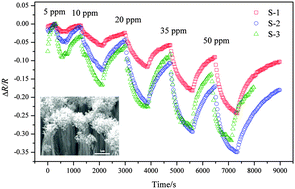ZnO nanorod/porous silicon nanowire hybrid structures as highly-sensitive NO2 gas sensors at room temperature†
Abstract
ZnO nanorod/porous silicon nanowire (ZnO/PSiNW) hybrids with three different structures as highly sensitive NO2 gas sensors were obtained. PSiNWs were first synthesized by metal-assisted chemical etching, and then seeded in three different ways. After that ZnO nanorods were grown on the seeded surface of PSiNWs using a hydrothermal procedure. ZnO/PSiNW hybrids showed excellent gas sensing performance for various NO2 concentrations (5–50 ppm) at room temperature, and the electrical resistance change rate reached as high as 35.1% when responding to 50 ppm NO2. The distinct enhancement was mainly attributed to the faster carrier transportation after combination, the increase in gas sensing areas and the oxygen vacancy (VO) concentration. Moreover, the p-type gas sensing behavior was explained by the gas sensing mechanism and the effect of VO concentration on gas sensing properties was also discussed concerning the photoluminescence (PL) spectra performance.


 Please wait while we load your content...
Please wait while we load your content...